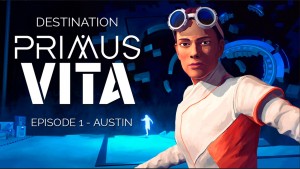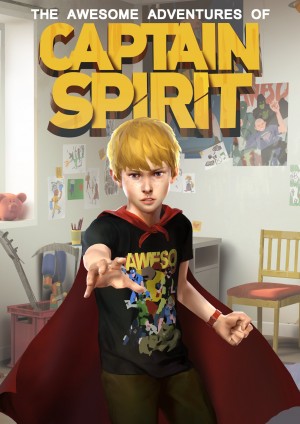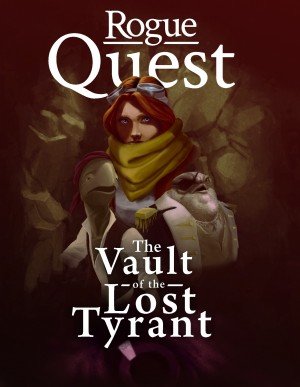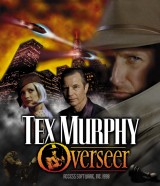Review for Destination Primus Vita: Episode 1 – Austin page 2
In many adventure games, our protagonists embark on perilous journeys that sweep them away to far flung places. But what if the journey happened internally instead, measured not in distance but rather the emotional growth occurring within ourselves? With Destination Primus Vita, the veteran designers at Epsilon Games have determined to explore this theme. Each installment of the six part episodic series will be told from the perspective of a different member of ‘Crew 121’ on an interstellar mission to save Earth from an alien menace. Despite the grand story playing out behind the scenes, however, the focus will rest primarily on the individual emotive and cognitive development of each person as they uncover revelations about themselves and each other. In Episode 1: Austin, your character never takes a single physical step, but by the end she will have landed light years away from where she started.
In the distant future, the planet’s water supply has been stolen by a race of metallic alien beings dubbed the “Shatters”. By tapping into reservoirs deep in the ground, the human race barely survives an ensuing dark age to re-emerge centuries later with the capability for interstellar travel. Believing the water has been taken to a planet designated ‘Primus Vita’, 30 light years away, they now intend to get it back. Six talented individuals are selected to journey aboard the ‘Beaufort Water Transportation Vessel’ on a mission to retrieve the stolen water and save the human race. You are among them: Austin Blair, the world's leading quantum physicist. You are also a judgmental workaholic. Your role in the mission is to reverse engineer the Shatters’ mysterious technology and adapt it for human use. The problems is that your tendency to neglect and assume the worst of your ‘friends’ and fellow voyagers has negatively impacted morale and created a significant emotional rift amongst the crew. This will need to be healed if the six of you are to work together as a cohesive unit and achieve mission success millions of miles from home.
Fortunately, your onboard AI system ‘NIM’ has a secret plan to assist you in mending your strained relations. While in cryo-sleep, each crew member is mentally plugged into the ship’s network, where they are able to interact in a virtual environment crafted and moderated by NIM. The game takes place in this digital realm, where NIM has full access to plumb the depths of your subconscious mind. You move through a series of surreal sci-fi environments, alive with color and pulsing with sound, solving logic puzzles and attempting to salvage embattled relations with your colleagues. The areas you visit alternate between memories of interactions with those close to you, where you discover that things are not always as they seem at first glance, and projections created by NIM intended to simulate your mission in the forward base you will utilize when you arrive on Primus Vita. Along the way, you are reminded that it’s a good idea to look up from your work every once in a while and cherish the moments you have with the ones who mean the most to you.
Heavy emphasis is placed on your relationship with the other crew members, which include Coby Blair, Lieutenant in charge of the mission and your younger brother; Artemis Gracco, soldier and longtime friend of the family; Hayao Mutsami, drug-addled botanist seeking escape from personal demons; BrX Stewart, fitness-focused engineer with a poor sense of direction; and Geny Obamsawin, communications specialist romantically involved with Coby. Each of these characters has their own motivations, hopes and fears. Austin also harbors her own dark, underlying story that unwinds throughout the course of the journey and reveals why she remains so distant from those around her.
One of the first things you notice about Primus Vita is its slick presentation. The game establishes its beautiful artistic tone right from the title screen and maintains it throughout the duration of the episode. In first-person perspective, you control your character with directional keys (WASD) and look around with the mouse. Movement is fluid and smooth while exploring the small but creatively engineered environments that contain pathways wrapping around walls, allowing you to traverse areas that once were ceilings. The user interface is crisp, and menu navigation is punchy thanks to well-designed audio cues. The game does not employ a manual save feature, opting instead for an autosave system, which can be a letdown since it only seems to record your progress at the start of each new area. There is no ‘Game Over’ screen or way to die, but failure results in being returned to the most recent checkpoint.
Throughout the adventure you are placed in a series of vignettes, usually joined by at least one other crew member, where the goal is to discover clues that further unravel the story. Progression to the next area is restricted until all narrative elements have been located and each logic-style puzzle solved in the current zone. Items that are interactive will generate a round white cursor when your camera is trained on them. Even with this it can be difficult to differentiate hotspots from the scenery, however, as the cursor itself often blends into the background. The game alleviates this somewhat by adding an audio ‘click’ to alert you when you are near something you can interact with.
There is no inventory system. Discoverable items include ‘mementos’ that detail a portion of the backstory and help to flesh out the game world, ‘puzzle clues’ which can be referenced later to help solve a challenging puzzle, and other elements within the scenery that, when clicked, help to advance the plot. Mementos are of particular value in building the game’s world. They can be mission logs from other crews who previously visited Primus Vita, news stories from Earth detailing the alien invasion, historical accounts of how life advanced with a diminished water supply, and even personal reports revealing the physical and psychological status of individual colleagues. Through these mementos, a broader, more epic backdrop is painted to lend perspective against the drama playing out in our virtual cryo-sleep theater.
When conversing with others, you will sometimes be presented with two timed dialog choices, only one of them the ‘correct’ answer. This will reveal something intimate about the character, enhance your relationship meter with them and open up another opportunity to converse with them later. The other option will be the ‘wrong’ choice and result in no advancement of your relationship. These response options are frequently ambiguous, and it is sometimes difficult to determine which will reward you with an extra point of affection. This is exacerbated by the autosave feature, which prevents you from being able to immediately restore your game at the beginning of the conversation if you select incorrectly. Instead, you must either exit the game and reload at the beginning of the current segment, eliminating all progress made in the scene up to that point, or deal with the error and move on. You are not presented with another opportunity to correct the decision later.
While making the wrong decision through no fault of your own can be frustrating, it may not be that great a loss, as there does not seem to be a significant benefit to increasing the relationship meter with any of your companions. Aside from potentially missing another conversation topic, the story seems to play out exactly the same way regardless of your affection levels. (Maybe this will be leveraged in some way in future episodes?)
A handy display in each area counts down the number of crucial items and dialog opportunities left to discover. By the time you have completed a scenario and are ready to move on to the next, you will have learned more about one of your peers and to some extent begun the process of revitalizing your relationship with them. At any time, you can access your ‘AR Menu’ to view your ‘Mind Stimulation Meter’ (game completion percentage), check on relationship meters with individual crew members (along with how many correct dialog choices you have made), recap the backstory by viewing collected mementos, and track how many puzzle clues you have discovered. It is easy to miss mementos and puzzle clues when advancement means you are locked out of previously visited areas, but the entire episode is relatively short (3-4 hours), so playing again for full completion should not be too much of a chore.
The result of a successful Kickstarter, Destination Primus Vita was designed by former members of Ubisoft who had previously worked on such acclaimed franchises as Assassin’s Creed, Far Cry and Prince of Persia. Nowhere does this professional experience shine through more than in the artistic design. What could have been a sterile, lifeless trek through a futuristic military vessel is instead a hypnotic journey through a technological wonderland alive with color and light. Simple but effective geometry evokes a Tron-like aesthetic with rooms and pathways spiraling up and around you to dizzying effect. Looking up to see an area you previously visited slanting sideways or suspended upside-down far above you lends the journey a fresh and unique feel, subtly reminding you that everything is playing out primarily in your mind. (The game seems like it would be a lot of fun to explore in VR.) An obvious amount of care went into the character designs as well. Models are rendered artfully, service uniforms look practical without being boring, and strange tattoos and glowing highlights like the blue luminescent bands interwoven into Geny’s braids all add to the whimsical sci-fi atmosphere.
Sound design is another area that excels. A muted synth wave soundtrack accompanies you throughout, adding ambience without ever becoming overbearing. It rises just enough to remind you it is there before falling again into the background, becoming an almost subliminal pulse that drives you forward. Sound effects are clean and satisfying. All dialogue is voiced, and the acting is fairly convincing.
Puzzles do not fare as well as the presentation, unfortunately. Almost entirely comprised of generic 2D logic puzzles, you will be asked to perform such feats as drawing a straight line through a weaving maze without crossing your own path, selecting which illuminated portions of a hexagonal pattern should remain lit versus which ones should be extinguished, and rotating pieces on a gameboard (or particle accelerator display screen) so that they all connect with one another and end up in some arbitrary position that the game deems acceptable.
On their own, these tasks do not offer any indication of how to solve them. There is no feedback mechanism to let you know that you are narrowing in on a solution or even hint at what that solution might be. This could make many of the puzzles a frustrating and endless endeavor in trial and error, but the designers provide you a lifeline through the clues you find while exploring, which appear on the left side of your screen, hidden behind an icon of a magnifying glass. Hovering your cursor over the icon will temporarily reveal a clue that is pertinent to the current puzzle you are attempting to solve. Sometimes this ends up being a genuine hint that will lead you closer to what the puzzle demands, but other times it is simply the answer, robbing you of the satisfaction of victory.
Occasionally, even though a clue might prove effective in solving a specific puzzle, it won’t make sense in the greater context of the game. One example of this is a puzzle that asks you to place colored spheres in specific locations on a circular grid in order to route power to a turbine. Earlier you had a conversation with Artemis about a night she spent playing poker, during which she went into detail about the seating arrangement of all the players that were in the room. For some reason, that conversation serves as the clue for how the turbine spheres should be aligned on the grid. If the game didn’t explicitly tell you that when accessing the hint system, it would take a big leap of logic to ever connect the two. I mean BIG – as in, you wouldn’t need a spaceship to reach Primus Vita big.
Another form of ‘puzzle’ are the maze segments. These are sections of the game where you will need to navigate a 3D labyrinth within a limited amount of time. There is only one correct path to the exit, and making a wrong turn will result in instant failure and reset you back to the starting point (it will also reset the timer). At first, these mazes can appear to imitate the trial and error futility of some of the other puzzles, only lacking the benefit of available clues. After making the wrong turn a few dozen times, I can imagine gamers throwing their mouse up in frustration and walking away. However, if you are patient and particularly observant, the game does provide the language necessary to master them. Stick with it and pay attention, and you shouldn’t have too much trouble.
Finally, the game does include several short Quick Time Events where you must try to survive a simulated Shatters attack. These segments cannot be skipped, but fortunately they only utilize the directional keys and the timing is extremely forgiving. Failure to press the displayed key within the allotted time results in starting the sequence over from the beginning.
Destination Primus Vita is noteworthy for its concept of a sleeping space crew interacting exclusively in a virtual environment, where we’re presented with reminders of the importance of using life’s obstacles to strengthen us, and how valuable trust can be in building relationships. Episode 1: Austin offers an intimate story of character growth set against an epic narrative backdrop, and excels in both atmosphere and graphical presentation, which are top-notch. Despite the shallow and poorly-clued puzzles that too often fail to reward cleverness or ingenuity, the first-person exploration remains entertaining throughout this debut installment, and ultimately the seeds planted here encourage coming back to witness their further development in future episodes.
Now, if you’ll excuse me, I’m off to drink a glass of water while I wait, since it may not be there tomorrow…





_capsule_fog__medium.png)



























